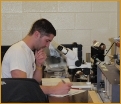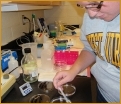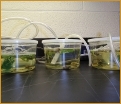Research: Lymnaea
Lymnaea palustris
System
The freshwater gastropod mollusc Lymnaea palustris is a useful laboratory organism since it is easily obtained, bred, and maintained year-round. We designed experiments to establish the suitability of this organism both as an experimental system and as a model for the developmental biology teaching laboratory. However, development from fertilization through hatching takes place inside an egg capsule of albuminous fluid and in order to manipulate the embryo for valuable embryological techniques such as blastomere separation or microinjection, the capsule must be punctured or removed entirely. We have established the viability of the embryo following such disruption, and tested a variety of methods to sustain and enhance survival of the embryos.
Reproduction, Growth, and Development
Lymnaea can also be used as a model for toxicological studies, using both adults and embryos. Environmental contaminants are of great concern to the health of aquatic organisms. Herbicides, pesticides, and fertilizers contribute to nutrient and contaminant runoff and accumulate in streams and groundwater. We established mesocosms containing sublethal concentrations of two fertilizers, the herbicide glyphosate, the insecticide permethrin, and a fungicide. Starting concentrations were based on EPA MCL (Maximum Contaminant Level) for each substance if available; in parallel, animals were exposed to 5-fold higher concentrations. Adult organisms’ growth, viability, and fecundity were monitored regularly. Embryos were subjected to the same or higher concentration of these substances, and their developmental abnormalities recorded. Our data demonstrate that adults and embryos respond to the contaminants tested in a dose-responsive manner, and that at concentrations legally permissible in drinking water, severe abnormalities result.
We have aimed to elucidate the potential action of RoundUp on reproductive processes through the use of L. palustris as a model system. Lymnaea and mammals share highly conserved steroidogenic pathways, and it has been demonstrated in vivo that RoundUp can disrupt mammalian StAR protein, which is critical in the conversion of cholesterol to steroid hormones. Whether similar effects could be observed in snails was tested by raising animals in different concentrations of RoundUp (1x representing the EPA maximum allowed concentration [MCL], with a 5x and 10x in parallel) and quantifying the number of eggs laid, and abnormalities in those eggs. Treatment with RoundUp showed significant effects in up-regulating reproductive rates and embryonic defects in the 1x and 5x groups while producing a higher mortality effect in the 10x group. Preliminary examination of total snail protein via Western Blot revealed cross-reactivity with StAR and cytochrome p450scc antibodies; thus, this procedure may be used to examine further the effect of RoundUp on the steroidogenic pathway.
Learning & Memory
We have demonstrated Lymnaea palustris can be used in behavioral studies. We used an operant conditioning schedule to screen for possible long-term memory (LTM) formation abnormalities following exposure to environmental contaminants. To stimulate pneumostome opening, snails were placed in hypoxic water, then subjected to three 45min sessions with one hour between the first two sessions and 24hrs between the second and third sessions. For each session, a tactile stimulus was applied for every instance of an attempted pneumostome opening. LTM formation can be assessed by a significant decrease in number of openings from the first session to the third. We are currently testing for abnormalities in LTM formation following acute exposure to glyphosate (Round Up). The three experimental sessions are administered in water containing 3500ppb glyphosate, five times the MCL for glyphosate in drinking water. Results indicate that treatment with Round Up or with glyphosate alone causes impairment in learning and memory.


